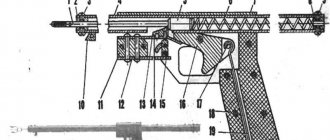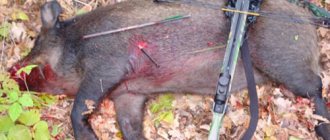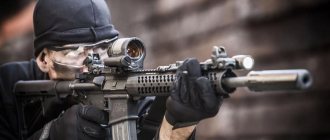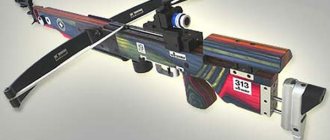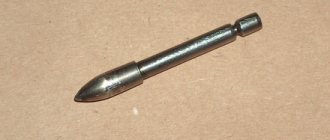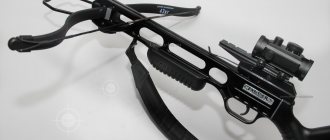We all remember our childhood, how we planed bows from tree branches or made crossbows. After all, before it was very difficult to buy a bow or crossbow just to play around, or even more so to go hunting with it. Nowadays, everything is different, you can just come to the store, choose a suitable model and buy it, or order it from us online. And therefore, every third of our clients has a question: what to buy, a crossbow or a bow?
Crossbows and bows are divided into two categories: classic and compound. Classic bow and crossbow systems have two arms and one string. When drawing the crossbow, the entire weight of the effort of the shoulders is held by the crossbow lock, and the release becomes a little rough. Block systems are a slightly trickier and more complex bow design - two arms, eccentric blocks, working and auxiliary bowstrings. The block system is easier to cock than the classic one - at first it’s tight, then, when the blocks are rotated, the bowstring simply “flies” into the lock, and the force on the crossbow lock is minimal, and the release is correspondingly soft. With bows everything is the same; accordingly, aiming with a compound bow is much easier than with a classic bow. Let's consider the options, since there are many options, but everything is in order. First, let's determine the purpose of purchasing a crossbow or bow.
For entertainment at the dacha, both are suitable, but again, if you want to hit the target exactly, then you should definitely use a crossbow, because crossbows are equipped with front sights and various sights, including optical ones. With a crossbow equipped with optics, hitting the target is easy, but again, depending on the distance. With bows everything is much more complicated. After all, there is no way to adapt optics to a bow, for example. To hit the target accurately with a bow, you need to train much more and gain experience, maintain the correct stance, etc.
When choosing a crossbow or bow for hunting purposes, some people simply want to shoot silently so as not to scare the animal, and some want to get food more honestly, as our ancestors did in those days when guns had not yet been invented. In this regard, hunting with a bow is considered more fair, because with a bow it is much more difficult to hit not only the animal, but its vital organs, because a hunter with a throwing weapon has only one shot - to kill. With a crossbow, everything is simpler, but still a little more complicated than hunting with a gun, because the flight of an arrow, unlike buckshot or a bullet, is more trajectory. Hunting with a crossbow or bow in our time usually occurs from ambush, one shot, and three options: the animal stands further in place, not understanding what happened and, bleeding, loses consciousness, or it immediately gives way and falls, or tries to escape, but how the rule is not far. Arrows are now made from high-strength carbon fiber, capable of piercing the shoulder blade of a wild boar or even an elk, and then you are armed with steel tips with blades made of surgical steel and a huge reserve of arrow flight speed.
If you are going to give a gift, then you cannot find a more original gift than a crossbow or bow, because it is both sport and entertainment, or it can simply become an excellent decorative detail in the home of the person to whom you are giving such an exquisite Thing, especially crossbows with carved wooden butts. A gift in the form of a sports or hunting bow will please a person no less than a crossbow. But you also need to choose the right bow, especially for classic bows. A classic bow is tailored to the height of the shooter, and this is very important. With compound bows it is easier, the main thing is that the shooter is physically strong, since compound bows are quite powerful and it is not easy to draw at first. But as a rule, almost every man, and even women, can handle a compound bow.
In general, this information will be key for you when choosing a crossbow or bow, and our professional sales consultants will select the optimal model and necessary accessories for you, based on your budget and purchasing requirements.
A crossbow is a type of throwing weapon in which the bow is rigidly attached to the stock in a horizontal position. This symbiosis allows the use of materials with a high coefficient of elasticity, thanks to which the crossbow became the first weapon with armor-piercing properties, and also significantly improves shooting performance. You can learn to use a crossbow much faster than a traditional bow.
A crossbow can be classified according to several parameters, but a more complete picture of it is given by their combination.
- Structurally
crossbows come in recurve and compound crossbows.- The first ones work solely due to the elastic force of the bow's arms. They were called recursive for their double bend, which, when the bowstring is tensioned, work counter-currently - one for compression, the other for tension. Popular recursive models: Yarrow (,), etc.
- The latter use the principle of a pulley system - a system of blocks and cables passed through them to overcome the elastic resistance of the shoulders. Well-known block models: , and , , and .
- By appointment.
Crossbows for hunting, sports, and for entertainment. - By type of ammunition used.
Short arrows (16 to 21 inches), darts (8 inches or less), and steel balls used by schnapper crossbows.
We will talk below about what is more powerful and, in general, better for hunting and sports, a bow or a crossbow, and how they differ from each other in comparison.
The video below will tell you which crossbow to choose, block or recurve:
Comparison with bows
So, crossbow versus bow.
- The main advantage of a crossbow is that learning to shoot from it is much easier. For the reason that the shooter does not need to do two things at the same time - hold the bowstring and line up the aiming line.
However, for this he had to pay with weight - together with the stock and trigger mechanism, it weighs at least twice as much as a classic bow.
- When drawing a crossbow, various devices are used. From the stirrup in which the foot is placed to hold it, to the mechanical tensioners. Thanks to them, you can use a bow that is much more elastic, strong, capable of throwing heavy arrows (bolts) with great energy and penetrating ability. For comparison: the maximum tension force of a hunting bow does not exceed 60 pounds - 27.3 kilograms, and for a crossbow, which has a similar recurve design, in its basic version it is 43 kilograms.
- Optical sights can be installed on crossbows - from collimator to diopter, which significantly increases shooting efficiency. In compound bows, the aiming line is much more complicated, using a pip-site (a ring in the string at the shooter’s eye level) and a scope sight. Classic and traditional bows do not have this set either. To hit the target with them requires great skill, acquired through long hours of training.
Read below about choosing a crossbow for underwater and land hunting, sports and entertainment.
How to get arrows for a bow?
You only have 2 ways to get bow ammunition:
- Find arrows during the passage;
- Craft arrows after finding a bow. You will receive the recipe for the arrows along with Robin Hood's weapon. To create them you will need 1 blade and 1 binding.
Be sure to search your enemies after being hit by arrows, because... sometimes it is possible to return some of the arrows back to Ellie.
How to choose a crossbow
In this matter, knowledge of the basics of mechanics and Newton's laws will be of great help. and first we’ll find out what and how to choose a crossbow for hunting (eg wild boar) and sports, what are the prices and reviews about certain models of weapons.
For hunting and sports
Let's make a reservation right away:
- Firstly, hunting using throwing weapons is prohibited in Russia.
- Secondly, none of the freely sold crossbow models has a pulling force exceeding 43 kilograms. Even if its cost is close to one hundred thousand rubles, and the manufacturer positions it as a hunting one. Anything above this value is subject to licensing as an assault weapon.
The stopping power of the arrow, due to its mass and geometry, is comparable to a 20 gauge bullet. Typically, hunting with smoothbore weapons takes place at distances of no more than 50 meters. Therefore, the term “hunting crossbow” refers to a weapon that is capable of throwing an arrow with such force that at a distance of 30 meters it loses almost no strength and can fly another hundred. To do this, it must have special technical characteristics, the main of which are the stroke of the bowstring and the tension force. Regarding the latter, we will assume that it is equal to the maximum permitted by law.
The stroke of the bowstring is the distance from the point where it intersects the upper edge of the forend to the holding tooth of the trigger mechanism. It ensures the duration of the force and sets the amount of energy transferred to the arrow. Directly depends on the arm span of the bow. For example, for a block crossbow, which is definitely capable of sending an arrow 100 meters and further, with a bow length of 61.5 cm, it is 37 centimeters. And the recurve Jaguar Interloper, which is used by many as a hunting weapon, has a bowstring stroke of 24.5 cm with a bow length of 67 centimeters.
The value of 24 cm should be remembered as the minimum that distinguishes hunting and sporting weapons from recreational ones.
In a compound crossbow, with a shorter bow length, the bowstring travel is greater. This is due to the design features - the high specific stretch coefficient of the cable system, which accumulates the bulk of the energy for the shot, and powerful arms that can be bent without fear of breaking.
But this is not the only difference. The diagrams of the force impulse during tension and release of the bowstring of recurve and compound crossbows are mirror opposite. With classic recurves, the force reaches its peak when the bowstring is placed on the tooth of the fighting mechanism. And it is spent almost immediately after descent. Blockers, on the other hand, experience a reduction in force by almost 70 percent, and it is consumed gradually, increasing to a maximum at the moment the arrow leaves the guide. Therefore, the flight speed of an arrow from recurves does not exceed 60; for blockers it reaches one hundred meters per second.
- Since the “blocker” has less force on the holding tooth of the trigger mechanism, it can be kept cocked longer without the risk of breaking the bowstring. Similar to the gas spring of air rifles.
- But recurve crossbows also have an advantage: they are simpler and lighter - the MK-380 weighs 4.5 kilograms, and the Jaguar Interloper 3.1.
The part of the stock, called the forend, of a hunting crossbow should be metal.
- Firstly, this allows you to make the bow block massive, dampening vibration and residual tension in the shoulders.
- Secondly, the trigger mechanism is attached to it and it should not dangle, which affects not only safety, but also shooting accuracy.
- In addition, it is possible that the plastic guide may become deformed when the bowstring is pulled.
Optical sights must be installed on hunting and sports crossbows, for which profile rails are used - Weaver, Picatinny, dovetail. Therefore, a recurve crossbow, which has a tension force of 43.4 kg and a bowstring stroke of 24 cm, cannot be considered as a full-fledged hunting one. It has a plastic guide, and the sighting devices are only external - a rear sight and a front sight without fiber-optic threads.
Sports shooting is less dynamic, but the requirements for results are higher. Remember the axiom that “the barrel shoots, but the stock hits.” Therefore, choose models with the ability to adjust the shoulder rest and in the bullpup form factor, which are more balanced. For example, the “” model, which is equipped with other “goodies”: a bowstring stabilizer, adjustable arrow bar clamping force, and an adjustable weaver bar.
This educational video will tell you which is better for hunting and sports, a bow or a crossbow:
Crossbows for fun
Any throwing weapon with a bowstring stroke of less than 20 cm can be considered recreational. First of all, these are crossbows in the “pistol” form factor. Man Kung companies produce a whole series with letters from to. All of them are recurve, but the body and guide are made of both plastic and metal. Their shoulder span is 42, and the bowstring stroke length is 12.7 centimeters. Tension force 23 kilograms. Ammunition - short arrows (darts) 16.51 (6 inches) centimeters long.
Their effective firing range is no more than 15 meters, so they are not considered hunting, but at this distance a “toy” crossbow is deadly.
Schnapper crossbows, which shoot steel balls, stand apart. All schnappers are block-type, with a rifle stock. In any case, the ball does not fly further than 15 meters, so they are classified as recreational weapons. Even if the length of the bowstring stroke exceeds 24 cm, like “”.
Compact models are more common. Such as "Tiger". Its arc span is 42.9 cm, and the tension force is 25 kilograms. In addition to steel balls with a diameter of 8 mm, it shoots darts 6 inches long. The dart does not fly further than forty meters. Known and , as well as .
Arrow selection
Crossbow arrows are available in lengths of 14, 16, 18, 20 and 22 inches. The recommended size is indicated in the operating instructions. It is acceptable to use a longer one. In any case, the arrow shaft should fit snugly against the guide along its entire length. Now they are made from the following materials:
- carbon - carbon fiber plus a binder;
- aluminum – hollow with replaceable tips;
- fiberglass (fiberglass).
Wherein:
- For hunting, heavy arrows are used, which fly slower but have greater penetrating power. These are full-bodied carbon (the heaviest) and aluminum, suitable for hunting small game.
- For sports competitions, aluminum and, to a lesser extent, fiberglass are used, which, due to their low weight, are highly susceptible to wind.
- Fiberglass, the lightest, is used for recreational shooting. In most cases, their use on serious crossbows is undesirable, since it is equivalent to a blank shot, leading to damage to the weapon.
Hunting arrows for ungulates have a massive metal tip, often with several blades. For better stabilization, their feathers are longer. For feather and small game hunting, a simple point is sufficient.
Arrows for compound crossbows have a moon nock at the end. They have two-color plumage - the stabilizer, which differs in color, is installed in the groove of the guide.
This video provides an overview of different crossbow arrows:
The review will be useful to all those who are interested in throwing weapons.
The bow is the only known type of weapon that has remained virtually unchanged throughout the history of its existence, which is no less than about 10,000 years.
The modern weapons industry offers many bow models, which can be divided into the following categories:
- block,
- children's,
- classic,
- sports,
- traditional.
Compound bows are most often used for sports and hunting.
The main differences between a traditional and compound bow are:
- The most obvious distinguishing feature is the design. Without exception, all traditional bows are an arch with a bowstring. Compound bows are equipped with special mechanisms located on the bow's limbs. Thanks to these mechanisms, less effort is applied during aiming (compared to a traditional bow). By and large, in this case the tension of the bowstring is practically not felt.
- Because bow designs are different, so is the shooting technique used.
- There is still no consensus on the power of these categories of weapons, since everything here depends not only on the characteristics of the weapon and arrows, but also on the skill of the shooter, as well as on weather factors.
- The compound bow has a very compact design, which greatly facilitates its storage and transportation. In addition, unlike a traditional bow, a compound bow can be stored without removing the string. At the same time, traditional onions need rest and special care.
- Alas, the compound bow is a type of weapon that can be expanded endlessly. Be prepared for additional costs when purchasing the base model. For reference: fully equipped models are marked with the abbreviation PKG (package - packed, completed).
Important: use of onions, incl. blocky, in hunting - this is already aerobatics! Bowhunting requires that you have a long history of hunting and a good understanding of bows! If not, then you should pay attention to filling gaps in knowledge.
It is better to fill in the missing information about weapons in an archery club or section. If visiting a specialized club is not available to you, study the teaching materials of Mikhail Khuskivadze, a coach who has trained many talented archers.
Do not forget that a bow is, first of all, a weapon that must be used in compliance with all safety rules.
What's the best way to upgrade a bow?
Total 80 units. parts for crafting - and an excellent bow sight will give you a pleasant bonus while hunting for adversaries! The upgrade will add a dot showing where the arrow hit - silent zombie hunting has never been so precise.
What is a crossbow, what does it look like: brief description, photo
The crossbow is an improved design of the traditional bow. The first attempts to make a more powerful weapon began in Ancient Greece, by the Middle Ages turning the crossbow into a worthy competitor to the bow.
Experienced users often divide crossbows into conditional groups:
- taking into account the design features: classic, block, pistol/rifle type;
- taking into account the purpose: combat (registration is required), sports, hunting, restored copies of ancient crossbows.
In addition, crossbows differ:
- taking into account the country of origin;
- to size;
- according to the material from which the weapon is made;
- by age arrow: adults and children;
- by arc location, etc.
In any case, before making a purchase, visit the nearest shooting range or club to form your personal opinion regarding the need for such an acquisition.
Important: do not buy a frankly cheap crossbow. It can be very dangerous for both the shooter and spectators!
One more note: experienced crossbowmen advise choosing a rifle-type crossbow. Such crossbows are an order of magnitude heavier, however, their power and firing range are usually higher.
When choosing a crossbow for hunting, consider the following:
- Classic crossbows are slower than block crossbows.
- The string tension of 50-60 kg is suitable for hunting large ungulates. To hunt wild boars, give preference to more powerful weapons. For hunting small game and birds, choose a weapon with the quietest loading/release possible.
- The crossbow handle should be made of a material that provides a good grip, regardless of weather conditions.
- Be responsible when choosing arrows for your crossbow. Remember: aluminum arrows are still a training option.
How to get explosive arrows?
Towards the end of the game, you can find a magazine from which Ellie will learn how to make explosives, as well as explosive arrows. A complete guide to all the journals in The Last of Us Part 2 and their locations can be found on this page .
Sometimes these arrows can be found among other items in the game, but they are a very rare and valuable find, so use them wisely.
Explosive arrows perform well in combat with crowds of attackers. One explosive arrow can kill more than 2 densely standing enemies. It is very good to use them against enemies who walk with annoying dogs.
Video: Bows and Crossbows - Civilian Weapons
This question is from the series “will a whale take an elephant?” appears with enviable regularity in search queries. It looks like it's time to more or less decide on the answer.
In order to immediately get over the pain and close the quantitative segment of the problem, I present the average indicators of “power”, but in fact - the energy and speed of projectiles (“”) of typical representatives of hunting bows and crossbows, as well as air rifles, spring-piston (SPP) and with preliminary pumped (PCP).
But first, oddly enough, data on firearms. They will be useful to us too.
| Weapon | Projectile weight (g) | Speed m/s | Energy (J) |
| Pistol (9x18) | 6 | 315 | 300 |
| Smoothbore gun (12x70) | 33 | 450 | 3350 |
| Carbine 7.62x54 | 12 | 770 | 3500 |
| Carbine 9.3x64 | 17 | 750 | 4800 |
So, let's go. Let me emphasize that we are considering standard products in their original (not weakened for Russia or Ukraine) design, without additional “overclocking”. But they all meet real hunting requirements. Only the objects of hunting are different, in weight - a thousand times.
Let's start with pneumatics.
| Weapon | Projectile weight (g) | Speed m/s | Energy (J) |
| Air rifle PPP “magnum”* 4.5 mm | 0,68 | 240 | 20 |
| Air rifle PPP “supermagnum”* 4.5 mm | 0,68 | 310 | 33 |
| PCP 4.5mm Air Rifle | 1 | 300 | 45 |
| PCP 12.7mm Air Rifle | 18 | 220 | 430 |
And one more thing: do not trust advertising.
All manufacturers and sellers indicate attractive speeds in the performance characteristics of their spring-piston rifles: “magnum” (18-25 joules) - 305 m/s, “supermagnum” - 360-380 m/s.
Reality looks completely different:
- for “magnum” (approx. 20 joules): “half a gram” (0.55 g) - up to 280 m/s, “heavy” (0.68 g) - 240 m/s. "Hatsans" (25 J) - up to 300 m/s with light bullets and 270 with heavy ones.
- for “supermagnum”: (29-33 joules): “heavy” (0.68 g) - 290-310 m/s.
Light bullets cannot be used with “supermagnums” - the result is an analogue of a destructive blank shot. Details in the articles "" and "".
Now it's the turn of bows and crossbows
| Weapon | Projectile weight (g) | Speed m/s | Energy (J) |
| Recurve bow 70 lbs | 23 | 75 | 65 |
| Compound bow 70 lbs | 23 | 106 | 130 |
| Recurve crossbow 225 lbs* | 25 | 100 | 125 |
| Compound crossbow 185 lbs* | 25 | 115 | 165 |
Well, we have answered the question “who is more powerful?” Are you satisfied? So I don’t!
In fact, all those asking him are not interested in bare numbers, but in the practical application of these types of weapons, that is, their lethality.
But it is radically different for arrow throwers and rifles.
Again, let's start with pneumatics. There is no fundamental difference with a firearm; the main task is to transfer the maximum amount of energy to the target, causing lethal damage to internal organs. To do this, it is extremely desirable to avoid a through wound, in which the bullet takes away part of this energy. But here lies the fundamental difference between the military and hunting approaches.
In the first case, the principles of humane methods of warfare have been in effect for a hundred years, in particular, prohibiting the use of expansive (explosive) bullets, and through wounds, on the contrary, are welcomed. Roughly speaking, the enemy must be given a chance. And to be completely honest, the costs of transporting, treating, nursing and paying a wounded person are much higher than burying a dead person in the field. Moreover, a lot of the enemy’s people are distracted from direct combat operations - you can’t abandon a comrade. This is the ugly homespun truth.
When hunting, the principle is exactly the opposite. There is also a kind of “humaneness” here: since the “infirmary-medal-disability benefit” is not given to the beast, it must be obtained quickly, if possible, avoiding unnecessary suffering. Hence the use of various expansive ammunition, where the bullet in the body begins to open up like a “flower” or disintegrate into segments. These fly worse than usual.
The photo shows a pneumatic expansive bullet.
The selection of ammunition is an eternal compromise between speed, flatness and stopping power.
This is especially true for pneumatics. She does not have thousands of joules of energy in reserve that, due to hydrodynamic impact, can create temporary pulsating cavities in her body, characteristic of firearms (pictured).
Therefore, special precision and accuracy are required from the shooter.
Before us is the “supermagnum” “,” which produces 310 m/s in a 4.5 mm caliber and 33 J of energy with a 0.68 gram bullet and is by far the most powerful serial spring-piston rifle.
Most biological targets designed for this power will be freely pierced with a lightweight, high-velocity pellet. The energy remaining in the flesh, especially when hit “locally”, is quite enough to catch a hazel grouse pigeon, even a rabbit (see “ ” and “ “). Just, for God’s sake, do not confuse hazel grouse with black grouse and especially wood grouse - these are completely different birds, the tiny musk deer and the huge elk are also from the same deer family.
However, from an ordinary 20-joule “magnum” - with an accurate hit to the head.
The point here is this. When hunting, game is often killed by a single “golden” pellet/buckshot. Sometimes the entrance hole cannot be found immediately, as if the animal died of a heart attack.
Bullets of 4.5 mm caliber in terms of weight and size characteristics approximately correspond to fractions from “00” to “000” (hare, fox, wood grouse). And if, at the end of the barrel, a single pellet is noticeably superior in speed/energy to a pellet, then with increasing distance this difference first levels out and then changes sign (in the “supermagnum”, of course, earlier). This is the advantage of rifled weapons, which includes almost all long-barreled pneumatics.
Different rifle, different approach. The Career Dragon Slayer is one of the most powerful pre-pumped (PCP) air rifles available.
A heavy 18-gram 50-caliber bullet (12.7 mm) develops only 220 m/s, but produces 430 joules. And all of them will go to the deer carcass, which is what such weapons and ammunition are actually intended for.
Such rifles also have disadvantages. In addition to the exorbitant price, these are short firing distances, low projectile speed and the associated ricochets of a round-headed bullet from any branch. But, again, if it hits “locally”, it has an acceptable stopping effect. Although when it comes to large animals, everything is not so rosy - see the final section of the article ““. But since August 2016, such weapons can also be used to throw heavy hunting crossbow bolts (see “ “).
Ammunition and its practical use are also discussed in sufficient detail in the articles “” and ““.
Features of the use of bows and crossbows
It is precisely the stopping effect that all arrow throwers, bows, and crossbows lack. In terms of energy, they are tens of times weaker than shotguns and rifles (see tables), and are used mainly for animal hunting. In historical terms, there were, of course, exceptions to the monstrous tension force cocked with the help of a gate and a partner. They fired heavy steel “bolts” and were intended to knock out armored horsemen, preferably piercing knightly armor. In a word, these are, rather, not small arms, but peculiar medieval anti-tank guns.
In combat and hunting, completely different devices were used en masse, and their damaging factors also looked different.
This is exactly how crossbow and archery hunting takes place now, where a mighty animal with a high pain threshold and level of “vital force” simply loses it, pierced right through with an arrow with razor-sharp tip blades.
This happens due to the cutting of blood vessels, causing rapid blood loss. Clearly, we are not talking about a sniper shot into an artery. Apart from the heart and liver, which are also very difficult to hit with a arrow thrower, the main target is the lungs. The organ is quite solid, paired, that is, located on both sides of the body, and also densely penetrated by a network of blood vessels.
With the blood, life gradually flows out. I have a suspicion that often the animal does not even understand what is happening to it, but simply runs away to the side and, feeling a sudden surge of drowsiness, lies down to rest.
This is if you don’t scare him, jumping out of cover with a triumphant cry. Then the animal “on adrenaline” is able to get away from the hunter for hundreds of meters, often to no avail.
For this type of hunting you will need a strong (at least 60 Lbs) compound bow
or a crossbow with hunting shoulders:
– recursive – from 200 lbs;
- block - from 165 lbs (some unique designs provide excellent performance even at 140 lbs).
With a bow, everything is very, very difficult, since shooting and hitting with it is much more difficult than with a crossbow. Even more or less easy-to-learn “blockers” have a lot of nuances, and not everyone can devote the necessary time to regular training, which is indispensable here. And only a few will be able to stretch a 70-pound hunting “recurve” without refined technique and the corresponding muscle groups developed by special exercises to a normal attachment.
The technique of shooting from a crossbow is almost no different from a rifle-rifle, adjusted for short shooting distances. In addition, there are a number of purely hunting devices that do not even have a bowstring as a class, but the speed indicators are unattainable for conventional crossbows, and visually they are more reminiscent of a modern assault rifle (see ““).
But there are also types of hunting where the arrow does not “sew”, but, like a bullet, transfers its energy to the game - for example, “feather” hunting. For these purposes, completely different tips, so-called “shockers,” are used.
Firstly, even a non-hunting bow is strong enough to do this. In any case, a regular one (pictured) will do.
And secondly, such spreading tips prevent the long flight of the arrow, and they also get tangled in branches and grass, and it is relatively easy to find it, even if it misses.
Subjective indicators of the power of bows, crossbows and pneumatics
If we are not talking about hunting, but about entertaining “shooting games” for a bet, then I can say the following.
A magnum-class spring-piston rifle sews a half-inch board right through, and splits some (apparently with defects). “Supermagnum” is capable of making holes in commercial rolled metal - mind you, with soft lead bullets. “Overclocked” rifles with modified ammunition make this easy. A blank fence made of corrugated sheets is not an obstacle for such pneumatics - keep this in mind.
A standard 95 lbs/43 kgf compound crossbow at a 30-meter distance usually splits already one-inch boards. Moreover, the arrow also stabs not too thick (up to 10 centimeters) trees, although it gets stuck in a split. She doesn’t notice corrugated sheeting and similar materials at all, only losing her plumage. In its hunting version, fired from a crossbow with original arms of 80-100 kgf, it destroys everything that gets in its way, including the rather frail scapula of a large animal.
A 40-pound recurve bow is much more loyal to various obstacles, mainly arrows. But a legal “blocker” with 60 Lbs hits not much worse than a forbidden powerful hunting crossbow.
Please consider all of the above information when choosing a shooting location (see “Where to shoot with a bow and crossbow?”). Health, including mental and financial health, is more valuable than entertainment.
In conclusion, I suggest you watch a wonderful video on the topic “arrow versus bullet” that we discussed today. True, we are not talking about pneumatics here, but some of its models are quite comparable in energy (“more powerful”) to the tested firearms. And, as we have already seen, the “air” is not fundamentally different from it.
And shooting at a shooting range. It should not be confused with a bow; compared to it, a crossbow has a number of advantages. It is more accurate, shoots and is stronger. In this article, we will look at the subtypes of crossbows and the main details that you should pay attention to first. After reading the article, you will learn more about crossbows and understand how to choose a crossbow.
When thinking about how to choose a crossbow, it is worth noting that different materials are used in production, which significantly affects the quality. This is mainly high-strength plastic, carbon or metal. The choice of material for the bowstring deserves special discussion. It is important that it is not affected by the weather situation - heat, cold and humidity. The bowstring should be made using Dacron or Kevlar, then its service life cannot be affected by temperature conditions.
When choosing a crossbow, pay attention to its power. Important!
In Russia it is prohibited to use crossbow models with a tension force exceeding 43 kg. They are considered throwing weapons and are subject to the law on liability for the possession, storage and use of weapons.
Types of crossbows
Crossbows are divided into:
Purpose
In this classification, crossbows are divided into sporting, hunting, historical and recreational crossbows.
The most popular are hunting crossbows with a draw weight of up to 80 kilograms. But you can shoot from them only on private property, at your own peril and risk, and state hunting zones are prohibited for them.
Crossbows for “historical” models are fully consistent with medieval ones, with one exception, the bowstring for them is made of modern synthetic threads.
By class, crossbows are divided into elite and ordinary
The main difference between one and the other is in the materials. Elite crossbows are made from high-strength materials. They are intended for shooters for whom it is important to have tangible proof of their status and individuality.
By age group
In this classification, crossbows are divided into adult and children's. Manufacturers of crossbows for children take into account that a crossbow is a powerful weapon, but in the hands of a child it must be safe, both for himself and those around him. Therefore, the arrows in children's crossbows are replaced with rubber suction cups and a plastic target is included.
By design
There are two types of crossbows - rifle and pistol. Let us dwell on these subgroups in more detail, since they are of no small importance.
Crossbows of rifle design owe their name to the butt, made in the likeness of a rifle. Safe and convenient weapon. Crossbows of pistol design also owe their name to the butt. easy to use, convenient to transport, and also because it can be used to shoot not only arrows, but also other sports equipment - balls, harpoons, etc.
By design, crossbows are divided into two more types: classic and block.
Useful accessories
What else is useful for archery:
- A shelf is
a device that helps hold the arrow in the desired position before firing, preventing it from deflecting horizontally or vertically. For each category of bows, special types of shelves have been developed. - Release, finger guard or glove
- devices to protect fingers from friction on the bowstring. Releases are used only by compound bow shooters, finger guards are preferred by athletes, gloves are the choice of traditionalists, although both of them can use both accessories. - Sights or scopes
– increase the size of the target significantly. Mainly used on sporting bows for long-distance shooting. - Stabilizers
– smooth out vibrations during aiming and after a shot, dampen recoil. Increases shooting accuracy and comfort. - A quiver
is a device for carrying and storing arrows, placed on the shoulder, on the belt or on the bow itself. Large quivers are designed to hold 20 or more arrows, small ones – up to 10. When purchasing a quiver mounted on a bow, you should choose a model from the same manufacturer as the bow. - A cover or case
is an accessory for storing and transporting a bow. - Shield
– designed for training or entertainment outdoors or at the shooting range. Arrows should be easy to stick into the shield material and no less easy to take out.
Scott-Caliper release (black handle) 6,228 for 1 piece.
Bow string MK-CB006 with cams 840 for 1 pc. Stabilizer for compound bow Shock Stop Camo 2 352 for 1 pc. Bowmaster quiver 47x32 cm, 3 inserts, 2 pockets, black 1,204 for 1 piece. Samurai release (black, buckle belt) 5,544 for 1 piece. Bow string Predator 1,714 for 1 piece. Shelf for classic bow TR magnetic RH 353 for 1 pc. Bow string MK-RB007 without cams 303 for 1 piece. Interloper MR1 hand release B10010A 1,568 for 1 piece. Dark brown suede quiver (clasp - buffalo horn) 5,600 per 1 piece. Sight for compound bow Hit Man 5 (5 pin level) 7,056 for 1 pc. Shark release (black, buckle strap) 9,089 for 1 piece. Bow string Cartel - B50 Recurve 70″-10 443 for 1 pc. Belt quiver advanced (red) 1,345 per 1 piece. Plastic shelf for classic bow KAP 51 for 1 pc. Release Jim Fletcher Fletchmatic Deluxe 102d 6,160 for 1 piece. The Trophy online store offers customers a large selection of crossbows and bows for hunting, sports and recreation, as well as a variety of accessories for them. Professional consultants will answer all your questions by phone and help you choose an option that meets all your needs. Contact us at a convenient time and get modern archer equipment produced by leading companies in the industry.
Classic crossbow
Classic or quite noisy, requires operating skills related to precise tension of the bowstring and aiming the projectile at the target. But when replacing a damaged bowstring, an important feature is revealed in it - the bowstring can be changed easily, without disassembling the shoulder assembly. The crossbow is also easy to reload, which is not available to all models. Recurve crossbows are well suited for those who like to be active and shoot for fun. It is believed that the highest quality and famous recurve crossbows are made in Canada by a company, but others are willing to argue with this statement.
Where can I get the Arablet in The Last of Us Part 2?
The crossbow is only available when playing as Abby, and is some kind of alternative to the bow, which is available to the first heroine.
On the first day of the game, during the passage of Seattle, you will find a crossbow when Abby explores the shipwreck site. After walking along the shore, go inside the ship, where you will find the second “silent killer” next to a human corpse.


